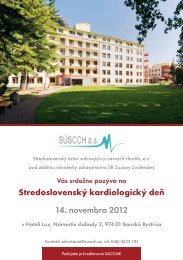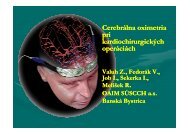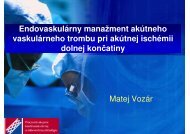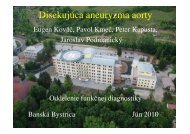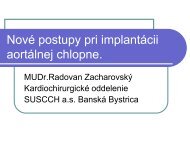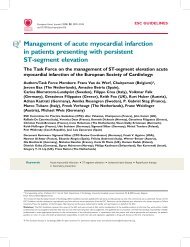Endovaskulárne techniky rekanalizácie femoropliteálnych okluzií
Endovaskulárne techniky rekanalizácie femoropliteálnych okluzií
Endovaskulárne techniky rekanalizácie femoropliteálnych okluzií
Create successful ePaper yourself
Turn your PDF publications into a flip-book with our unique Google optimized e-Paper software.
Clinical follow-up in endovascular treatment for TASC C-D lesions in femoro-popliteal<br />
segment. Rabellino M et al. Catheter Cardiovasc Interv 2009; 5: 701 - 705<br />
Objective:<br />
To demonstrate the technical success and clinical follow-up after endovascular treatment of femoropopliteal<br />
segment TASC II C and D lesions.<br />
Methods:<br />
From July 2002 to February 2007, 234 limbs in 190 patients with femoropopliteal segment TASC II C (n = 112)<br />
and D (n = 122) lesions were treated. Endovascular treatment consisted of PTA, fibrinolysis and PTA,<br />
subintimal recanalization and PTA, and finally stent graft. Patients were clinically evaluated at 30 days, 3, 6<br />
month, and at 1 year in the outpatient setting with clinical examination and ankle-brachial indices (ABI). In the<br />
case of stent placement, additional ultrasound evaluation was performed at 12, 24, and 48<br />
month.<br />
Results:<br />
49.5% of procedures were performed on patients with lifestyle-limiting claudication (IC) and 50.5% were<br />
performed for critical limb ischemia (CLI). Technical success, defined as successful recanalization and<br />
treatment of the occluded vessel, was achieved in 97% of cases. Periprocedural mortality was 3.15% and<br />
all deaths occurred in the CLI group. A follow-up 13 ± 6 months and was achieved in 76%. During the<br />
follow-up, clinical outcome for IC group and clinical CLI group was asymptomatic 72% vs. 29.8%,<br />
symptomatic with clinical improvement 22% vs. 33.7%, and major amputation 3% vs. 23.3%.<br />
Conclusion:<br />
The majority of claudicating patients with femoropopliteal TASC II C and D lesions will benefit from the<br />
endovascular treatment. Patient presenting CLI have a worse outcome, nevertheless the endovascular<br />
treatment can delay amputation, preserving the native vessel and does not impede surgical bypass if needed.<br />
For this reason, we consider that endovascular treatment may be the first choice treatment even in<br />
femoropopliteal TASC II C and D lesions. © 2009 Wiley-Liss, Inc.



